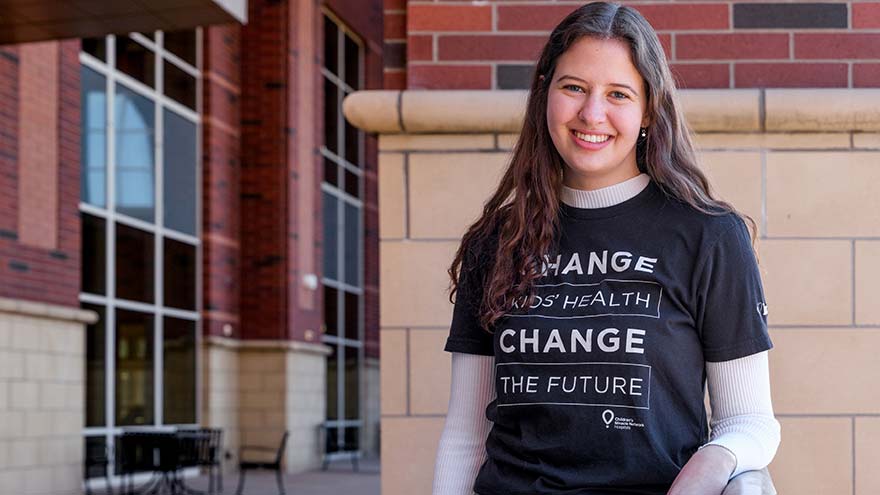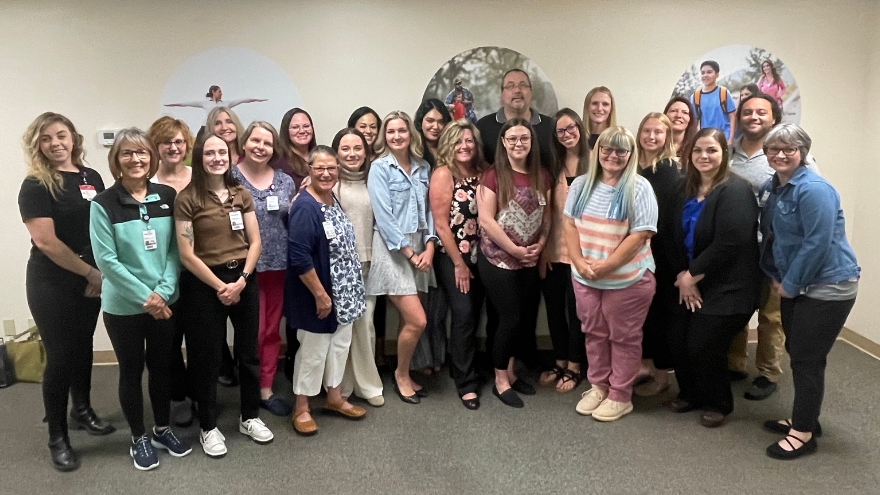Search
-
Preventing Spinal Cord Injuries: What to Know
If you're not taking safety precautions during mountain sports, you could be at risk for a spinal cord injury. Dr. Benjamin Pence of Renown Rehabilitation Hospital explains the best way to prevent this serious injury. Mountain sports are a big part of the winter season here in our area, but if you’re not practicing all the proper safety techniques, you could end up with a serious spinal cord injury. Benjamin Pence, MD, Renown Rehabilitation Hospital, is here to offer tips to prevent this serious injury while you’re out enjoying what the Truckee Meadows has to offer. What is the spinal cord? The spine stretches from the base of your skull to the coccyx (commonly referred to as the tailbone). Your spine is made up of 24 vertebrae—seven cervical, which are in your neck, 12 thoracic, which are in your chest, and five lumbar, which are in your lower back. There are ligaments and muscles attached to each vertebra. These facilitate back movement and protect the bones from damage. There is cartilage between each vertebra which acts as a shock absorber for your spine. Finally, the spinal cord is a long, thin, tubular bundle of the nervous tissue and support cells that is enclosed in the spinal canal and send signals from the brain to everything from your arm and leg muscles to bowel and bladder function. The brain and spinal cord together make up the central nervous system.
Read More About Preventing Spinal Cord Injuries: What to Know
-
What is Disordered Drinking?
An alcohol problem can affect anyone at any age. Many factors, including job stress, genetics or depression, may contribute to the start of disordered drinking. Drinking alcohol exists on a continuum. For example, if someone feels down in the dumps for some time, it doesn’t mean they are clinically depressed. So if someone goes through a period with above-normal alcohol consumption, it doesn’t necessarily mean they abuse alcohol. Although “alcoholic” and “alcoholism” are common, they are not clinical descriptions. Alcohol use disorder is the preferred term. Symptoms are often mild but can be the start of a more significant problem. According to the National Institutes of Health (NIH), over 16 million adults live with alcohol use disorder. Symptoms of Alcohol Use Disorder Do you recognize any of the following symptoms in yourself or someone you know? Drinking more or longer than intended Trying to cut down or stop drinking but not able to Having to drink more than you once did to get the same feeling Being annoyed when family members discuss your drinking Regretting your behavior while you were drinking
-
Why I Give: Sarah’s Story
As an avid soccer player, Sarah saw her fair share of doctors growing up. However, it wasn’t until she was diagnosed with celiac disease, an autoimmune disease affecting how the body ingests gluten, that she became passionate about healthcare. “I couldn’t figure out what was going on,” Sarah said. “I was getting sick, and my symptoms were getting worse.” Thankfully, after seeing a handful of doctors, she was on the path to recovery. “I remember being so relieved, and still am! Now I can focus on getting better,” said Sarah. The most important change people make after being diagnosed with celiac disease is the shift to a gluten-free diet. For many, Sarah included, living gluten-free is a lifestyle change. Thankfully, Sarah sees significant improvements in her health after adjusting her diet. “No one should just accept their symptoms as part of life,” said Sarah. Her increased awareness of health and nutrition motivated Sarah to study biology at the University of Nevada, Reno (UNR). “I want to be a pediatrician so I can help patients, especially kids, figure out treatment plans.” said Sarah who credits her experience living with celiac disease as her inspiration. Dancing for Kids’ Health Currently a senior at UNR, Sarah is a member of Phi Delta Epsilon, a co-ed international medical fraternity. Together with her classmates, she is bringing new energy and ideas to philanthropy. Sarah and the members of Phi Delta Epsilon are doing things differently and in many ways redefining what it means to give. This year, they are on a mission to raise funds for kids’ health at Renown Children’s Hospital. And they are doing this by dancing. The UNR Dance Marathon is part of the Miracle Network Dance Marathon, a student-led, year-round philanthropic movement that unites students across the United States and Canada. Collectively, they raise critical funds for Children's Miracle Network Hospitals. And Renown Children’s Hospital is our northern Nevada CMN partner hospital. Since 1991, over 400 college campuses and thousands of students have raised $300 million for kids. Sarah is the executive director of UNR’s chapter. “So far this year we’ve already raised $10,000 for Renown," said Sarah. Most of the fundraising happens on the day of the dance marathon. But throughout the school year, students hold mini fundraisers on campus and in the community. One hundred percent of the funds raised stay local, impacting Renown’s youngest patients. For every dollar donated, 18% helps provide charitable care, 15% goes to life-saving equipment, 12% supports medical research and 55% provides education, patient services and advancement services. “It's inspiring that we banded together to help kids in our community,” said Sarah. Last year they raised over $18,000. They are hoping to exceed that number at this year’s dance marathon in April.
-
Slow Cooker Chicken Potato Soup
A warm, comforting bowl of soup is always perfect for a winter meal. The creamy potatoes, tender chicken and vegetables in this recipe will make this a unique favorite. Even better – you can prep this gluten-free recipe in your slow cooker and freeze the leftovers.
-
Easy Overnight Oatmeal
Organize your morning meal the night before with this easy, refrigerated, ready-to-go recipe. Fiber-rich oats are full of omega-3 fatty acids, folate, and potassium and can lower LDL (or bad) cholesterol levels and help keep arteries clear. Start your day the heart-healthy way!
-
What to Expect at a Well Child Checkup
A well-child checkup is a great opportunity to monitor your child’s growth and development, and it's also a chance to establish a trusting relationship with your child’s pediatrician and have your questions answered. What to Expect at Each Checkup At every checkup, a comprehensive physical examination will be conducted to assess your child's growth parameters, including height, weight and head circumference. A developmental assessment will evaluate the progress of your infant or young child in achieving age-appropriate milestones, encompassing language skills, motor development, problem-solving abilities and psycho-social skills. In addition, your pediatrician will address common concerns such as feeding, sleep patterns, oral health and general infant care. Unless there are specific needs or concerns for your baby, routine laboratory tests are typically unnecessary. Your pediatrician will provide guidance on immunization schedules, post-vaccination expectations and when to seek medical attention. Furthermore, during each visit, you will receive age-specific guidance to help you anticipate your child's expected growth and development, along with essential safety precautions and illness prevention measures. Your pediatrician will discuss various topics, such as placing your baby to sleep on their back, utilizing rear-facing infant car seats until around age two, maintaining home water thermostats below 120 degrees Fahrenheit, ensuring dangerous objects and poisonous substances are out of sight and reach, emphasizing dental health and promoting the use of bike helmets, among other things. Preparing for Your Visit It is recommended that, as a parent, you write down any questions beforehand, so you don’t forget them in the moment. Most importantly, feel comfortable asking your pediatrician about anything that might seem unusual, as you are the parent, and you know best! Before leaving the pediatrician’s office, be sure that you fully understand any instructions given to you and ask for clarification if needed. From your child’s birth through young adulthood, you will be visiting your pediatrician regularly. The American Academy of Pediatrics provides what a regular schedule might look like. Well-Child Checkup Schedule Two to three days after birth and at one month Two months Four months Six months Nine months One year 15 months 18 months 24 months 30 months Three years, and yearly after
-
Department Spotlight Community Care Management
When thinking about taking care of your total health, what comes to mind? Perhaps participating in your annual check-ups, taking your prescribed medication, eating a nutritious diet, checking in with your mental health, the list goes on and on. Now, put yourselves in the shoes of someone who may not know where their next meal may come from, someone who may be homebound and not have access to transportation, someone who may be on a fixed income, someone facing homelessness or even someone who may be struggling with substance abuse issues. Getting healthy – and staying healthy – comes with a unique set of obstacles, or social determinants of health, for these patients to overcome. Inequities around social determinants and health behaviors have an outsized impact on patient outcomes, and social and economic factors make up 40 percent of those inequities. This is where the caring and compassionate community health workers, social workers and registered nurses that make up Renown’s Community Care Management (CCM) department rise to the occasion. As the need for resources grows in northern Nevada, these dedicated team members fill those gaps and ensure every patient feels prepared, educated and equipped with everything they need to continue their care journey and live a healthy, fulfilling life. Defying Disparities When our community at risk faces healthcare disparities, it can create complications in each patient’s life that may keep them from addressing their healthcare needs and affect the likelihood of them being admitted or readmitted to the hospital or continuing to struggle with their care management – but not on CCM’s watch. Whenever possible, the CCM team steps in to provide critical resources, education and care journey guidance for any patient that finds themselves in need. “In the simplest terms, we do outpatient case management with vulnerable populations,” said Barb Mader-Scherrer, Director of Community Care Management. “It may be anyone from elderly people who need help managing chronic diseases, to patients experiencing homelessness who are being discharged from the hospital. We work with folks who are facing all sorts of challenges.” Several roles make up the CCM department, including Community Health Workers. These team members are the resource experts, on the front lines of helping educate patients and supporting them as they navigate through the facets of their care. Their main goals? Avoid admissions and readmissions to the hospital and continue to meet their unique goals. “I have the pleasure of working with patients who may need financial help, transportation help or even help utilizing the food pantries in our community," added Steve Arm, Community Health Worker. “We help patients navigate healthcare and social services, address social determinants of health, encourage self-efficiency and provide general health education for many chronic conditions. We also provide home visits for our patients who need extra support.” “The day in the life of a Transitional Community Health Worker is to outreach to the patient while being admitted, do a bedside assessment, complete the social determinants of health evaluation and provide any resources needed to avoid readmission,” added Sherrie Skaggs, Community Health Worker. “Our main population is Medicaid, and many are homeless and financially challenged. As needed, we continue to ensure that follow-up is completed, and all needs and goals are met.” For those learning to cope with their condition and needing hands-on help especially after discharge, the CCM Social Work Care Coordinators take on this complex aspect of the healthcare journey. These individuals provide support and intervention for Renown patients facing a chronic, behavioral health or substance dependency condition to improve their overall quality of life beyond hospital walls, developing a strong framework to build a long-term healthcare plan. “As social work care coordinators, we help connect patients with mental health resources, welfare programs, community support, caregiver burnout resources, placement for loved ones with terminal illnesses and much more,” said Irina Osmolovska, Social Work Care Coordinator. “Requests that come to us run the gamut of homelessness, family crisis, food insecurity and even situations where a patient has no electricity for their life-saving medical equipment. We receive challenging requests and are always ready to go above and beyond to advocate for our patients.” Possessing a profound understanding of the delicate balance between medicine and the patient spirit, the CCM RNs help bridge the gaps between the hospital or primary care practice and post-discharge settings, ensuring a smooth transition for patients as they move from one healthcare setting to another. With their expertise in care coordination and patient education, these RNs help enhance patient outcomes and promote continuity of care. “Our group is responsible for making discharge follow-up calls to patients who have Medicare, as well as scheduling their hospital follow-up visit if needed,” said Vanessa Alford, Consulting RN. “The goal is to have every patient see their primary care physician within 14 days of discharge for continuity of care and to prevent readmissions. We also screen patients for eligibility for Chronic Care Management or Personal Care Management. In addition to setting up the patient for follow up, I review each patient's medications, answer any questions they may have about their medications and health conditions.” As another important part of unpacking the intricate web of social determinants impacting health, CCM RN Care Coordinators have the extraordinary opportunity to extend this department’s compassionate care beyond the boundaries of the traditional in-office environment. Whether it be through virtual connections, heartfelt conversations over the phone or in-person encounters outside the hospital, RN Care Coordinators create holistic and enduring plans of care for individuals facing chronic challenges – including behavioral health issues and chemical dependency struggles – at every stage of life. All in all, the CCM department recognizes the interconnectedness of physical, emotional and social well-being for all patients, fostering a sense of wholeness and empowerment to ensure they continue to meet their goals and live healthier, happier lifestyles. “Our team has a holistic approach to our work,” said Barb Mader-Scherrer. “We look at the whole picture. What are the medical things we can do for this person? What education do they need to help them manage their condition? Do they have food in their house? Do they have a safe living environment? Are there substance abuse issues? Do they need help in managing their medications?” “My 18 years of experience in various areas of hospital nursing and home health have given me the knowledge to serve patients in our community holistically, and I feel good about what I do,” added Vanessa Alford. “I hope that I am able to lessen the load on the medical assistants and providers in the clinics so they can focus on their patients on site.”
Read More About Department Spotlight Community Care Management
-
Department Spotlight: Imaging
The imaging department is where scientific precision and patient connection come together in harmony to help diagnose a multitude of conditions. When a mystery needs to be unraveled, experts in X-ray, CT, MRI, ultrasound, echocardiography, mammography and nuclear medicine step in to provide a deeper lens into each patient’s inner workings. At Renown Health, our imaging specialists exemplify this and more. With the inpatient teams at Renown Regional Medical Center and Renown South Meadows Medical Center and many outpatient locations across Reno and Sparks, our dedicated and compassionate imaging and radiology technologists make this symphony of healing a melodious reality. Through the lens of their expertise and the state-of-the-art equipment at their fingertips, the invisible becomes visible, pain transforms into answers and the path to recovery. A Picture Tells a Thousand Words Every patient image tells a story, and Renown’s Imaging department is full of master storytellers. From X-rays that capture the intricate architecture of bones to MRIs that unveil the complex structure of organs, these team members use sophisticated techniques to make sure every patient receives the highest standard of care. Within the imaging landscape, no day looks the same – and each team can expect a different set of challenges to overcome, all while helping providers gain better diagnostic clarity. “Every day in imaging is a little bit different, and I love that,” said Savannah Terrana, Outpatient CT Scan Technologist at Renown X-Ray and Imaging – Vista. “We start like everyone else: getting our rooms stocked and ready for patients and protocoling the day's exams. We have a lot of different types of scans, like x-ray, CT and bone density, and a variety of conditions that we are evaluating for the ordering providers, like fractures, cancer, bleeds and more. “When we get into work, we get a daily assignment that decides whether we are in one of our outpatient or inpatient rooms,” added Ireland Bennett, Echo Technologist at Renown Regional. “Then when we are on inpatients, we get our assignments for whether we are assigned to transesophageal echocardiograms, the cath lab or pediatrics. When we are on outpatients, we get a set schedule for the day with patients every hour from 7:15 a.m. until 4:15 p.m. We do our best to be efficient as possible to not delay any patient care or discharges.” “X-rays aren’t just for bones; we do chest X-rays to look for pneumonia and intestinal issues, and we also do fluoroscopy, which is a live video X-rays while patients drink contrast or while surgeons fix fractures with screws and other hardware in the operating room,” said Amethyst Winters, Inpatient Diagnostics Imaging Lead at Renown South Meadows. “There is a lot of variety, and we provide imaging for patients in the entire hospital.” Equipped with advanced technologies and the unique skills they acquired in a trade program, at the university-level or in the military, the Imaging department can deliver precise and comprehensive information to help providers make accurate diagnoses. And their role transcends beyond the image scanner. “A typical day for an MRI Technologist depends greatly on outpatient or inpatient settings,” said Sean Fryer, Supervisor of Imaging for Renown X-Ray and Imaging – Pringle. “There is a lot of screen time and usually in dark areas, but this is where our technologist skill set comes into play – manipulating parameters to either increase quality by signal/resolution or decrease them a little to gain time." “A day in the life as an ultrasound tech would of course be performing ultrasounds on our patient community, but there is much more to it,” added Mary Rushton, Ultrasound Specialist at the Renown Breast Center. “This includes keeping rooms clean and stocked with supplies, protocoling exams and studying patient history so you can give the best patient care possible, continuing education and training to keep up with new technologies and being an aide to your radiologist. Working with many different personalities, you recognize that you cannot complete every step of the patient care process all by yourself – it requires collaboration from your team to give the ultimate patient care experience." Mary brings up an excellent point about the wide variety of people her team meets every day, on both the patient and employee side, with the common goal of solving diagnostic mysteries. This aspect of their work has become one of the highlights of their career. “Working in imaging allows us to meet many members of our community,” Teresa Shutts, Breast Health Coordinator at Renown X-Ray and Imaging – Pringle. “We are responsible for providing imaging exams, managing patient needs and creating a comfortable and caring environment for people who are possibly going through the worst times of their lives.” Along with every day being different, our Imaging team members thrive in their dynamic and fast-paced work environment, where efficiency and urgency are vital, especially among a constant stream of patients in need of timely diagnoses. “Our days in CT are very fast paced,” said Shelly Lavin, Imaging Lead for Inpatient Diagnostics at Renown Regional. “Our modality is the first choice for assessing stroke and trauma patients. We are fortunate to have very competent tech aides who help work up CT orders by checking orders, IV status and labs. We generally have inpatients scheduled every half hour, and we work these around a very full ER list. When we get extremely busy, we have to strategize how we schedule our patients in the various scanners to expedite exams and not delay patient care.” “We provide patient care for those who come in for emergencies, trauma, inpatient care, surgery and fluoroscopy studies,” added Sean Elliott, Inpatient Radiology Technologist at Renown Regional. “I was always told in school that our main purpose was to help doctors better diagnose patients, and imaging provides many modalities to appropriately diagnose.” Behind-the-scenes, our Imaging surgery schedulers are the keys to ensuring each appointment runs smoothly, communicating directly with patients to get their exams off to a good start. “Every day it is my task to make sure we have everything we need to do the exam that is ordered for a patient,” said Isela Gonzalez, Surgery Scheduler for Renown X-Ray and Imaging – Double R. “This includes the order, authorization approval, completing the protocol, confirming the appointment, re-stating the address and directions, going over any prep for the exam and giving them their estimate cost for the exam. I always do my best to give the patient the best experience possible.” Whether they are in the weeds of radiology or in the depths of patient coordination, Renown’s Imaging department is unmatched – and the direct beneficiaries are their patients.
-
What Does a Doula Do?
If you’re expecting a new baby, you may have been given the advice to hire a doula. You may have seen statistics of improved outcomes among those who’ve had a doula attend their birth. Perhaps you’ve heard that the etymology is from the Greek word meaning “to serve.” But how does a doula serve their clients? A doula is a non-medical birth professional who will guide you through labor, birth, postpartum and beyond. Your doula can discuss your options with you so you can make informed decisions, as well as provide emotional and physical support to ease your experience. While each doula offers their own style, there are certain services that most doulas will provide for their clients. Typically, a birth doula will provide at least one prenatal visit, one postpartum visit and continuous support during active labor. A postpartum doula usually provides support during the 12 weeks immediately following birth, sometimes referred to as the “fourth trimester,” but some will continue care after that as well. Simply put, a doula provides informational, physical and emotional support during the childbearing year(s). Let’s take a closer look at these three ways a doula can support you. The Basics If you don’t know your options, you don’t have any. This is a common phrase in the world of birth work. When you’re in labor, you’re exhausted, in pain and there’s often urgency inherent or implied in any choices you make. So, when an intervention is offered, many birthing people accept it without question. One method that can help the decision-making process is to check your BRAIN: Benefits: What are the benefits of the proposed intervention? Risks: What are the risks of the proposed intervention? Alternatives: What are the alternative options? Intuition: What does your intuition tell you? Nothing: What if we do nothing? What if we wait? When you’re in active labor, you might have difficulty remembering this acronym; that’s where your doula comes in. At your prenatal visits, you can ask your doula for guidance in preparing your birth plan, which can include contingencies for certain potential interventions. And as choices arise during labor, your doula can guide you through the benefits and risks and can provide you with alternative options you might not otherwise be aware of that are available to you. Your doula can remind you to check in with your intuition and can help you quiet your mind so you can listen to your instincts. The Body Although we tend to see depictions of people giving birth on their backs with their feet in stirrups, this is only one of many ways to give birth. Walking and dancing can speed up early labor. Side-lying or hands-and-knees can prevent tearing during the pushing stage. Sometimes labor stalls, and a change of position is often helpful to get things moving again. Your doula can suggest positions depending on your stage of labor. Some labor positions might require the support of another person – your doula could fill this role or assist your partner in doing so. Some doulas also provide massage or even acupressure, and most will do the “hip squeeze” that so many laboring people swear by. If your baby is presenting posterior, or “sunny side up,” your doula can apply counter pressure to alleviate back pain during labor. Some postpartum doulas will do light housework while you rest and bond with your newborn. Others might care for your baby through the night so you can catch up on sleep. Many doulas have also gone through additional training to offer breastfeeding support and may be able to assist you with latch issues and nursing positions. The Mind Pregnancy, birth and postpartum periods can be some of the most emotional times in a person’s life. A doula will hold space for you and help you process your emotions before and after birth. It’s normal to feel apprehensive, or even fearful, about labor and birth, and discussing these feelings is the first step. A doula can help you navigate your concerns in a safe space so you can be prepared emotionally for your upcoming labor. Many doulas will also guide you through writing your birth plan, which can lessen anxiety about the unknown. If you have a history of trauma, your doula can assist in communicating this, so you don’t have to relive the experience every time you meet a new medical provider. Most people will experience some form of what’s often called the Baby Blues in the immediate postpartum period. The third day after birth tends to hit hard, as hormones attempt to regulate, but the Baby Blues can continue for weeks for some new parents. A postpartum doula’s support can be incredibly valuable during this time. When the baby blues last longer than a few weeks, it could considered a mood disorder. Most doulas will recognize signs of postpartum mood disorders and will have resources available for additional support. Choosing the Best Doula for You With so many wonderful doulas in northern Nevada, you might wonder how you could ever choose just one to attend your birth. Some expectant parents are unfortunately restricted by cost. With so many expenses related to a new baby, it can be difficult to budget doula services as well. Thankfully, Nevada Medicaid now covers doula care, and some commercial insurances are following suit. Check with your insurance company to find out if they might cover part of the cost for hiring a doula. If your insurance doesn’t cover doula services, some doulas offer a sliding scale based on income. You may want to interview multiple doulas to find the right one for you. If you’re the kind of person who wants all the information you can get, a more detail-oriented doula might be the best choice. But if you tend to feel overwhelmed by too many options, you might prefer a doula who only offers additional information as the situation calls for it. If you want massage or acupressure during labor, you might want to hire a doula with those certifications. Or maybe informational and physical support are not as important to you as emotional support, in which case your best choice could be a doula who has experience with postpartum mood disorders or trauma support. Regardless of who you hire, be sure to clearly communicate your desires and expectations – not just for your birth, but also for your doula. The most important thing when choosing your doula is trusting your gut. You need to feel comfortable with your doula, as they’ll be tending to you at one of the most vulnerable times in your life. When you find a doula that you click with, who listens to you and supports your choices, you have found the best doula for you.
-
Living with COPD? How to Maximize Your Summer Experience
June offers an official welcome to summer and the height of outdoor activities in northern Nevada such as hiking, camping, days spent at the lake and embracing long days and warm evenings with friends and family. Enjoying all that the summer season has to offer may not be as easy for those living with chronic obstructive pulmonary disease, or COPD, which effects more than 15 million Americans. What is COPD? COPD is a group of lung diseases including emphysema and chronic bronchitis that result in airflow blockages from the lungs. People may experience frequent coughing and shortness of breath among other symptoms. COPD typically impacts adults ages 65 and older and is becoming increasingly more common among women. Although smoking plays a key role in the development of COPD, air pollution and indoor air quality, and respiratory infection also contribute to disease development. While there is no cure for COPD, limiting progression of disease and managing symptoms can be achieved through lifestyle changes, therapy, and medications. Tips for Living with COPD This Summer, and Always Stay Hydrated: Staying hydrated is extremely important for people with COPD, especially during the summer. Not drinking enough water can make breathing more difficult because it increases respiratory symptoms. Make sure to always keep a water bottle with you and aim to drink 8-10 glasses of water daily. Be Mindful of Temperature: COPD symptoms can be exacerbated by hot weather. It is best to participate in outdoor activities during the cooler times of day, like the morning or evening. Check Air Quality Before You Go: Before engaging in outdoor activities, be sure to check the air quality index and plan your activities accordingly. Pace Yourself: Exercising can be difficult for people who have COPD. To make the most of your summer, try not to push yourself too hard and take breaks when you need them. If you start to feel out of breath or tired, take a break in a cool, shaded area until you feel better. Take Matters Into Your Own Hands To address the needs of community members living with COPD, the Renown Health Research Office has teamed up with Pulmonary Medicine to provide patients who are former or current smokers and have a history of frequent exacerbations with an option to participate in the ARNASA study. "COPD exacerbations have a huge negative impact on patient’s lung function” states Dr. Farah Madhani-Lovely, Chief of Pulmonary Medicine at Renown Health and Assistant Dean of Clinical Research at the University of Nevada, Reno School of Medicine. “We have had inhalers and prednisone for decades but patients are still having exacerbations. Now we have a new pathway we think will prevent exacerbations which is what this clinical trial is designed to prove.” This study will evaluate the efficacy and safety of astegolimab compared with placebo in participants 40-80 years of age with COPD. “This study in particular is so exciting because of the enthusiasm from the sponsor’s end” says Katie Buckley, Lead Clinical Research Coordinator working on pulmonology studies at Renown’s Clinical Research Office. “Often times sites aren’t assigned particularly passionate or engaged personnel who aid in carrying out these studies, but you can tell Roche Genentech’s team truly cares about the success of the study, the safety of their participants, and proving the efficacy of the investigational agent. Working on a study like this takes a village, and when the individuals on all ends share similar mindsets and work towards success as a collective unit instead of as individual moving parts, it’s amazing to see everything we’re able to accomplish.” Renown’s team of expert pulmonologists and researchers are available to join patients with COPD in support of their healthcare journey. If you are interested in learning more about this clinical trial option at Renown Health, talk to your pulmonologist at your next appointment or contact us at 775-982-3646. At Renown Health, our goal is to make it easy for patients to access clinical research as a care opportunity where patients can access a variety of standard care treatment options for their health condition or choose to participate in a clinical trial. For more information about clinical trial opportunities available to you or to ask any questions, contact the Renown Research Office at Renown-CRD@renown.org or 775-982-3646.
Read More About Living with COPD? How to Maximize Your Summer Experience
-
Top 5 Health Benefits of Pickleball
Over the past couple of years, pickleball has become the fastest-growing sport among people of all ages. It’s a combination of tennis, ping-pong and badminton that originated in 1965. This sport can be played indoors or outdoors on a pickleball court where two players (singles) or four (doubles) hit a perforated hollow plastic ball over a 36-inch-high net using solid-faced paddles. A pickleball court is the same size as a double’s badminton court and measures 20×44 feet. Pickleball is a fun, low-impact game that keeps people healthy and active. Kaitlyn Jacobson, Physician Assistant at Renown Urgent Care – Ryland, plays pickleball herself and is a big fan of the sport. Here she shares the top five health benefits of playing pickleball.
-
Questions to Ask Your Neurologist at Your First Appointment
When it comes to your neurological health, seeking the expertise of a specialist is crucial. The Renown Institute for Neurosciences provides comprehensive care for complex diseases affecting brain, spinal cord and peripheral nerves. Let us help guide you through the appointment process to ensure a productive and informative first appointment. What to Expect at Your First Appointment at the Renown Institute for Neurosciences Duration and Purpose: Your first appointment will last approximately one hour. This time allows the doctor to ask specific questions, do a thorough neurological exam and discuss your concerns. Specialized Care: You will be matched with a provider who specializes in assessing and treating your specific ailment or condition. This tailored approach ensures that you receive care from an expert who has the specialized interest and expertise to address your needs effectively. Initial Assessment: During your visit, you will first see a medical assistant who reviews your medication history and standard screening questions provided by your doctor. Following this portion of your appointment, the neurologist will ask specific and detailed questions about your condition and conduct a non-invasive neurological examination to evaluate your brain and nervous system functioning. This exam involves painless tests assessing your cognitive function and nerve operation, including tests for sensation, strength and coordination. Treatment: After performing the neurological exam and addressing your questions, the neurologist will review the possible diagnosis and treatment plan, including any medication needs to help with your condition. Finally, your doctor may discuss the role of additional testing, including imaging studies (CT/MRIs), peripheral nerve testing (EMG) or brain wave testing (EEG), which will be scheduled for a later date. Making the Most of Your Visit To make your appointment as beneficial as possible, consider the following tips: Arrive Early: Plan to arrive at least 10 minutes early to fill out any necessary check-in items before your appointment's scheduled start time. This will ensure a smooth and timely visit. Bring Insurance Information: Have your insurance details readily available to facilitate the administrative process. This will help avoid any delays or confusion. Gather Medical Records: If you have received treatment or undergone tests with other healthcare providers relevant to your condition, bring along any medical records or test results. This information will assist your neurologist in gaining a comprehensive understanding of your medical history. Prepare Questions and Concerns: Consider noting the following, which can help you better answer questions the neurologist may ask during your appointment. The frequency, duration and severity of your symptoms. Share information about any medications or treatments you have tried for the condition and the outcomes. Prioritize questions to help the neurologist answer your most significant concerns during the initial visit. Your first appointment with a doctor at the Renown Institute for Neurosciences is an opportunity to receive expert care and gain insights into the best method of treatment for your condition. By understanding what to expect and following the tips provided, you can maximize your visit and be on your way to achieving overall health and wellness.
Read More About Questions to Ask Your Neurologist at Your First Appointment











